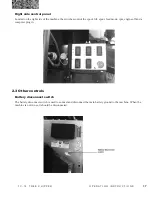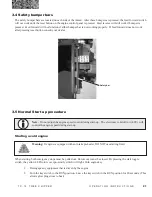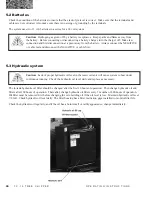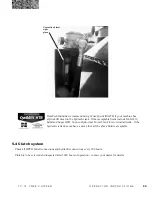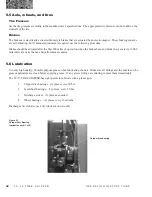
23
T C - 1 5 T R E E C H I P P E R
O P E R A T I N G I N S T R U C T I O N S
3.7 Engage Chipper Disc
1. Engine must be at low idle RPM to engage the clutch.
2. Press and hold clutch engagement button on the clutch control panel.
3. If the clutch control system fails to engage the clutch after the start sequence is complete, turn off the
engine and inspect the disc housing and feed area for obstruction. Be sure that the disc is not rotating
before servicing. (See 3.13 Unplugging Procedure)
4. Repeat step 2.
3.8 Adjusting Engine Speed
Use the up and down arrow keys on the engine management display to control the engine RPM. The engine will run at
two preset engine RPM, Either 850 rpm (low idle) or 2400 rpm (high idle)
3.9 Select Feed Speed (RPM)
On the right control panel located at the right side of the chipper, the switch labeled RPM is used to set the feedroll
speed and enables the auto height sensor if installed. Tree Mode is intended for chipping small log and brush with a
faster feed RPM. Log Mode is intended for larger logs 6” diameter or larger. It has a slower feed RPM and enables the
auto height sensor if equipped. Auto feed speed is always on and will stop when low engine RPM limit is reached, then
reverse briefly to help the engine RPM recover.
3.10 Feed Forward/Reverse
Located on either control panel, the switch labeled FEED will start the feed wheels when pressing FWD or REV. If the
light bars were contacted to stop the feed wheels, then auto feed reset must be pressed prior to FEED FWD. FEED Rev
is momentary and requires the button to be held down to keep reverse engaged. If going from FEED FWD to FEED
REV, then FEED REV must be pressed to turn off FEED FWD and pressed and held to engage FEED REV.
Engine must be at high idle and the chipper turning (clutch engaged) for FEED FWD to work.
3.11 Feeding Chipper without Auto Feed Height
1. Never enter feed hopper while engine is running.
2. Always stand to the side of the feed hopper while feeding the chipper to avoid being pulled into feed
hopper by trailing branches, standing to the side of the feed hopper insures access to a safety bar.
3. Cut pieces into manageable sizes. Trying to feed logs too heavy or branches not easily handled by one
operator increases the chances of strains and fatigue.
4. Load trees and limbs so the trunk end of the limb enters first with crotches and brush after. Once material
has engaged the feed wheels and is advancing, step back from infeed hopper to avoid trailing limbs and
branches.
5. When loading larger diameter logs, using the feed wheel lift to open the feed “throat” reduces the force
required to push the log into the opposing feed wheels.
Summary of Contents for TC-15
Page 2: ...Clearing the Way for a Better Tomorrow...
Page 4: ...Clearing the Way for a Better Tomorrow...
Page 49: ...41 T C 1 5 T R E E C H I P P E R O P E R A T I N G I N S T R U C T I O N S...
Page 50: ...42 T C 1 5 T R E E C H I P P E R O P E R A T I N G I N S T R U C T I O N S...
Page 54: ...46 T C 1 5 T r e e C h i p p e r P A R T S R E F E R E N C E T R A I L E R A S S E M B L Y...
Page 60: ...52 T C 1 5 T r e e C h i p p e r P A R T S R E F E R E N C E D I S C A S S E M B L Y...









